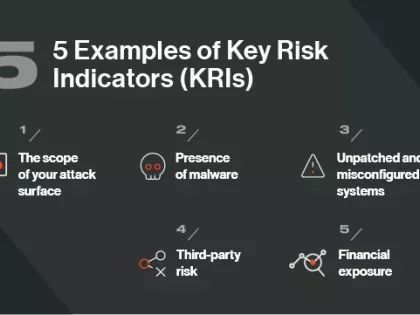What is cyber risk exposure and how can you manage it?


Cybersecurity is not an easy task. New threats are constantly emerging—in your IT infrastructure and that of your vendors and partners.
But, as a cybersecurity leader, you can help your organization mitigate these threats if you adopt cyber risk exposure management practices.
In this blog, we explore everything you need to know about how cyber risk exposure and management can help you reduce the risk of gaps and vulnerabilities in your network and across your third-party supply chain.
What is cyber risk exposure?
Cyber risk exposure is the sum of the vulnerabilities and risks associated with your organization’s digital footprint, including on-premises and cloud systems, applications, data, networks, and remote devices.
But, as your digital ecosystem expands, becomes increasingly interconnected, and new attack methods arise, your cyber risk exposure can grow over time, making it difficult to get a handle on potential vulnerabilities or emerging risks.
Your security teams face an uphill struggle to reduce this exposure and are constrained by three challenges:
- Siloed vulnerability monitoring tools: As the attack surface expands, so do the available tools to monitor and manage cyber risk across the various facets of your IT infrastructure. Because these tools are siloed, they fail to provide a complete view of risk.
- Alert overload: A plethora of tools results in alert overload that can overwhelm security teams who lack the time or context to help prioritize remediation efforts.
- Reactive response strategies: Security pros lack insights and are stuck in a cycle or reacting to threats rather than preventing them.
Hackers know this and continuously probe your network—and your supply chain—for the weakest link. Once penetrated, they often go undetected and move laterally in search of digital assets, seed malware and ransomware, breach data, and more.
What is cyber risk exposure management?
Cyber risk exposure management is the process of continuously identifying, prioritizing, reporting on, and remediating security issues—so that you can manage and reduce the risk of gaps or vulnerabilities in your network and across your third-party supply chain.
For example, if you add a new cloud instance or software vendor, or acquire a new subsidiary, exposure management ensures that the risks associated with these changes are properly monitored and managed.
A robust vulnerability management framework can help you assess and prioritize vulnerabilities based on factors such as the severity of the vulnerability, business criticality of the asset, potential impacts of exploitation, and so on.
With these insights, you can control exposure and remediate risks in a proactive and timely manner. This process should be supported by periodic vulnerability scans or cybersecurity assessments, thereby ensuring that your security program continuously evolves.
4 steps to managing cyber risk exposure
To manage cyber risk exposure you must understand your expanding attack surface and then prioritize vulnerability management and remediation using a combination of people, process, and technology. Consider the following four steps.
1. Use tools to automatically scan and inventory your attack surface
The more digital assets you have, the more chance one or more of these has a vulnerability. Indeed, the average organization has about 165,000 digital assets, including cloud-based devices, applications, data assets, and users. Another issue is shadow IT, where departments and users use software, services, or devices without the knowledge of IT and the appropriate security controls
Attack surface scanning can help you understand the true extent of your attack surface and where risk lies hidden. Instead of jumping between siloed tools, you’ll get a complete view of your attack surface—on-premises and in the cloud—so you can better visualize areas of vulnerability and disproportionate risk and prioritize remediation.
2. Form a cyber exposure response team
The responsibility of responding to cyber threats doesn’t just reside with IT or the Security Operations Center (SOC), it requires a coordinated effort from various organizational disciplines.
For example, while your security team and SOC focus on managing any immediate threat, legal and risk management teams must be on hand in the event of data or regulatory exposure. Your communications and customer success teams must also work alongside other stakeholders (including sales) to communicate with customers, partners, vendors, and so on.
Meanwhile, HR managers must be prepared to field questions and concerns from employees, especially if their personally identifiable information (PPI) is at risk or exposed.
To ensure your cyber exposure response team is always prepared, develop a process for incident response and conduct regular red team exercises and drills.
3. Continuously monitor for emerging cyber risk exposure
The best way to stay ahead of risk exposure—without alert overload—is to shift from a reactive state to a proactive mode. Instead of responding to risk as it arises, continuously monitor your attack surface to proactively prevent the next threat.
It’s no longer enough to perform annual or bi-annual security audits or penetration tests. You need to keep continuous tabs on emerging risks.
Continuous monitoring is the process of automatically monitoring your digital environment so you can discover unknown vulnerabilities and gaps in your security controls, such as unpatched systems, misconfigured software, open ports, and anomalous user behavior. Instead of waiting for the results of an audit, with these continuous insights you can keep a pulse on your cyber health in near-real time and act quickly when risk is detected.
4. Assess risk exposure from third parties
Extend the same due diligence and vigor to your third parties. After all, 62 percent of network intrusions originate with a third-party and 73 percent of organizations have experienced at least one significant disruption from a third-party in the last three years.
In addition to performing security assessments during onboarding and ongoing security audits of your most critical vendors, you must continuously monitor your vendors’ security postures for cyber risk and vulnerabilities. Take advantage of third-party risk monitoring tools for greater insight into your vendors’ security postures so you can be more proactive in preventing and responding to supply chain hacks.
With the right technology, you can:
- Quickly identify red flags for cyber risk and ensure vendors are within risk tolerance–before you sign the contract.
- Continuously monitor and track changes in your vendors’ security postures throughout the life of the relationship for rapid, proactive, and collaborative remediation.
- Automatically discover risky fourth-party relationships and alert your vendors.
- Detect emerging zero-day vulnerabilities in your vendor ecosystem so that you can prioritize your response, work with your vendors on remediation, and track their response.
Get a handle on cyber risk exposure
As cyber attacks continue to rise, managing your cyber risk exposure must be a top priority for your organization. Bitsight’s integrated solutions address this challenge.
With Bitsight you can gain complete visibility of risk exposure for continuous measurement of security effectiveness, remediation of vulnerabilities, and insights that guide decision-making. Bitsight also seamlessly extends that same visibility to your supply chain so you can reduce third- and fourth-party cyber exposure—quickly and confidently.
See what Bitsight can do for you. Request a free demo.


